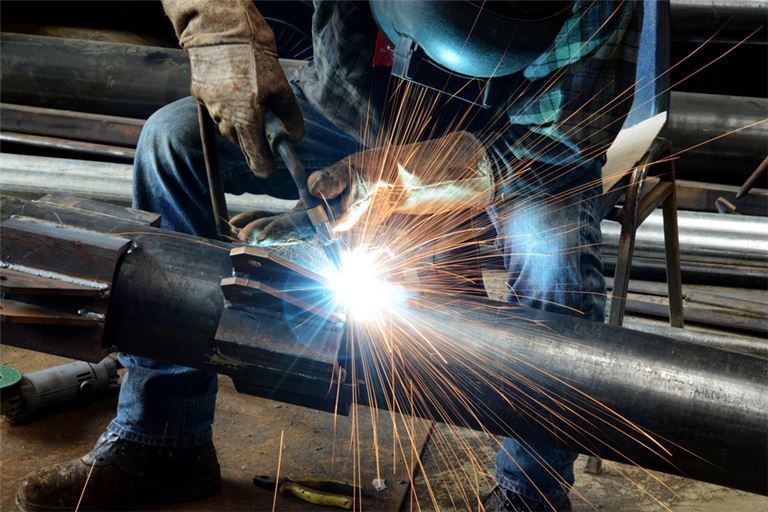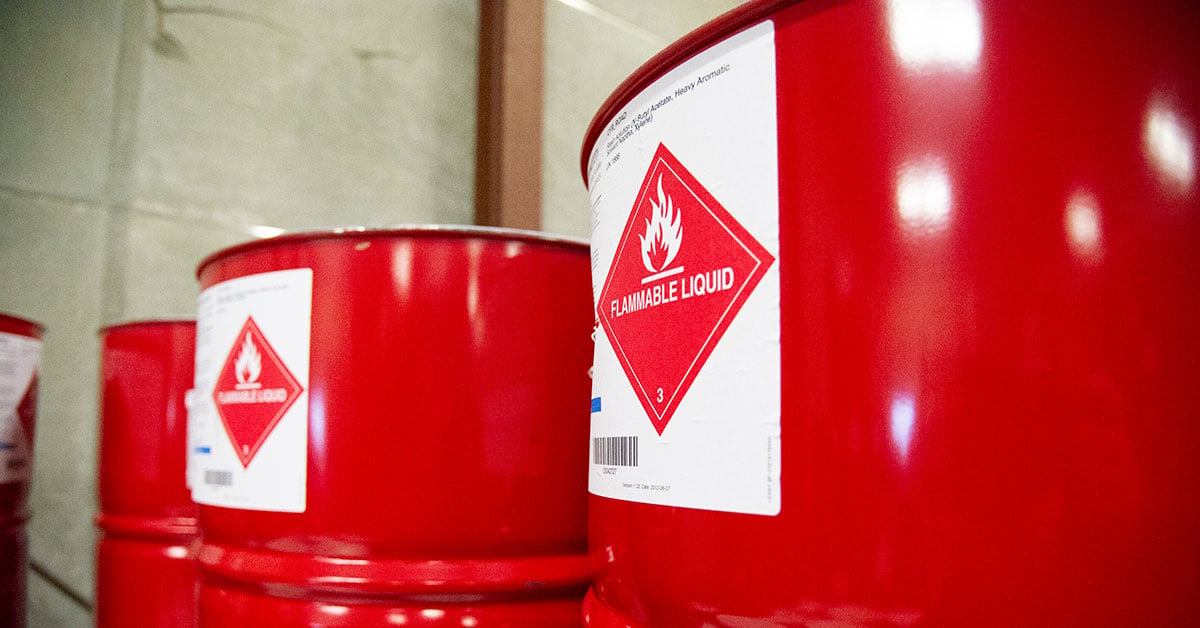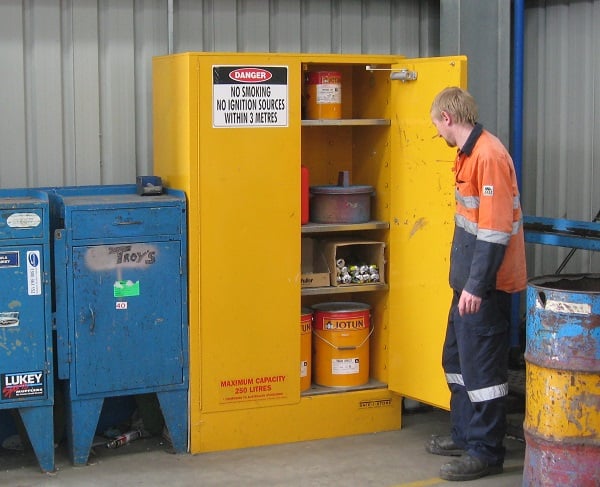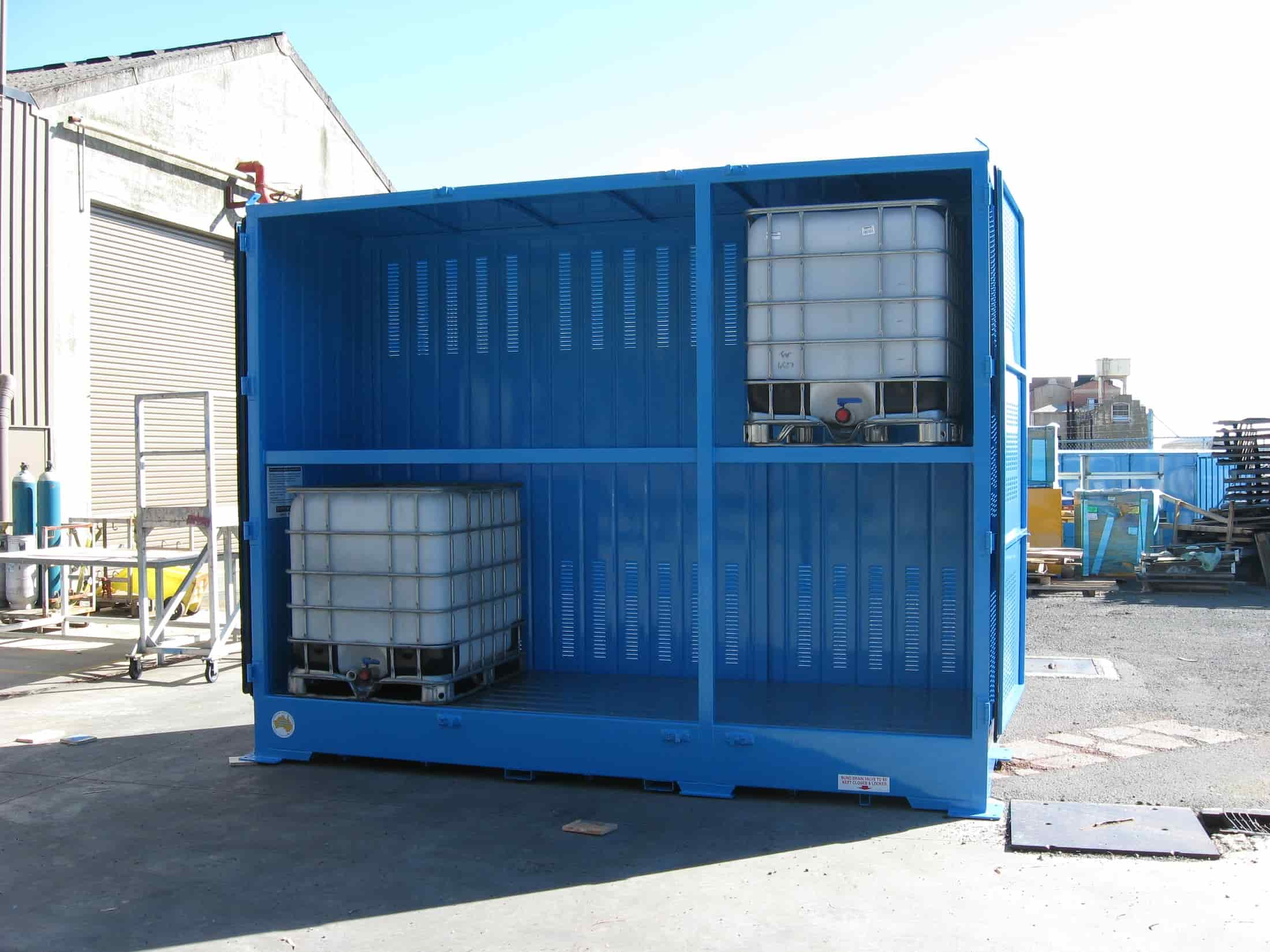If you work with any kind of flammable liquid — whether it’s in a manufacturing facility, a laboratory or a mechanical workshop — you probably are already aware of how important it is to handle and store the chemical safely. As a class of Dangerous Goods that’s widely used across a broad range of Australian workplaces, flammable liquids are an essential product — but also a hazardous one. To help your organisation stay safe and compliant, we’ll be answering the question, ‘What is a flammable liquid’, and offering advice on how to avoid the risks and hazards that are associated with carrying this substance in your workplace.
How Do You Define A Flammable Liquid?
The Australian Dangerous Goods (ADG) Code provides us with a detailed definition of flammable liquids:
Flammable liquids are liquids, or mixtures of liquids, or liquids containing solids in solution or suspension (for example, paints, varnishes, lacquers, etc., but not including substances otherwise classified on account of their dangerous characteristics) which give off a flammable vapour at temperatures of not more than 60 °C, closed-cup test, or not more than 65.6 °C, open-cup test, normally referred to as the flash point. This class also includes:
(a) liquids offered for transport at temperatures at or above their flash point; and
(b) substances that are transported or offered for transport at elevated temperatures in a
liquid state and which give off a flammable vapour at a temperature at or below the maximum transport temperature.
As you can see from the above definition, the key chemical property that defines a flammable liquid is the substance’s flash point.
What Is A Flash Point?
The flash point is the lowest possible temperature for vapor from a flammable liquid to ignite when triggered by an ignition source. Many everyday objects, like a cigarette lighter or an electric lamp, can be ignition sources. If flammable liquids meet an ignition source, they will ignite easily and burn fast. Due to this risk of fire (or explosion), it’s vital that anyone handling or storing flammable liquids is trained to identify and eliminate ignition sources.

Flammable liquids are defined by their flash point and ability to ignite easily in the presence of an ignition source.
The flammability of each flammable liquid also varies, so it’s essential that you check the Safety Data Sheet for each chemical to determine the safe storage and handling guidelines for its use. Some highly volatile flammable liquids include petrol and diesel fuel, while less volatile flammable liquids include substances such as diethyl ether and carbon disulphide.
The Globally Harmonised System (GHS) is a classification and labelling system that can help you responsibly store and handle your flammable liquids.
This system classifies flammable liquids into one of 4 categories — as defined by their flashpoint.
The following explains the GHS category criteria for this chemical type:
Flammable liquids:
1 - Flash point < 23°C and initial boiling point ≤ 35°C
2 - Flash point < 23°C and initial boiling point >35°C
3 - Flash point ≥ 23°C and ≤ 60°C
4 - Flash point > 60°C and ≤ 93°C
When you’re dealing with flammable liquids with a very low flash point, there can be a greater risk of fire, explosion and human harm. However, any flammable liquid, regardless of its flash point, has the chemical properties to ignite in the presence of an ignition source. Therefore, it’s important the control measures are in place to minimise risk in your workplace.
NOTE: GHS categories 1 to 3 are the same as the ADG Code for packing groups I to III. Category 4 flammable liquids as defined in the GHS overlap with C1 combustibles, as defined in the Australian Standard AS 1940:2017.
What Are The Risks Associated With Flammable Liquids In The Workplace?
Before we discuss the right way to keep flammable liquids contained, let’s get serious about the very real consequences of failing to do so.
Some flammable liquids, such as 2-propanol, release a vapor which has the potential to spread over long distances. This flammable, colorless liquid has a sharp odor similar to surgical spirits. Exposure to 2-propanol vapor can cause irritation in one's respiratory tract or eyes. It can also induce headaches, nausea, dizziness, drowsiness, incoordination, and confusion.
If stored in an environment without natural ventilation, the vapor from flammable liquids can build up over time and have adverse effects on your respiratory system. Inhaling large amounts of these toxic fumes – as a staff member might on an average working week – can result in fainting spells or suffocation.

If your flammable liquids aren’t properly contained, hazardous and flammable vapours can spread through your workplace raising the risk of human harm, fire and explosion.
This is just one example of a particular type of flammable liquid that can cause harm the staff in your organisation. However, all flammable liquids pose serious risk.
In addition to the vapours causing a wide range of health problems, they can also ignite if they travel close to an ignition source — whether it’s a hot surface, an open flame or a malfunctioning piece of electrical equipment.
Ensuring that your flammable liquids are properly contained and stored not only addresses the issue of harmful vapours being emitted, but it reduces the likelihood and impact of a chemical spill. If flammable liquids leak or spill out in a workplace, there is a real danger of these chemicals causing a serious, if not catastrophic, incident.
Guide To Safe Flammable Liquids Storage
If your flammable liquids aren’t stored in the correct way, they may threaten the safety of workers and pose a risk to property and the surrounding natural environment.
The Australian Standard AS 1940:2017 – The storage and handling of flammable and combustible liquids details specific requirements that should be applied when working with this class of Dangerous Goods.
Indoor Store Requirements
It’s not sufficient to store flammable liquids in just any Dangerous Goods safety cabinet. You must choose a safety cabinet that’s been constructed to meet the requirements of AS 1940:2017.

When storing flammable liquids indoors, use a cabinet that’s been constructed in full conformance of Australian Standards.
Some key construction requirements for flammable cabinets include:
- Double-walled sheet steel construction for the walls, floor door and roof, with a minimum space between walls of 40 mm
- Liquid-tight spill containment compound at least 150 mm deep
- Perforated shelves to allow for free air movement
- Self-closing, close-fitting doors, held shut automatically by catches at least 2 points
- Materials of parts critical to structural integrity should not melt at temperatures less than 850 °C
The flammable cabinet reduces risk in a variety of ways:
- Protecting the flammable liquids inside the cabinet from damage and heat
- Containing and directing any chemical spills or leaks to the spill containment sump
- Providing vapour containment within the cabinet
- Creating a protective barrier in the event of a fire that allows a 10-minute window for evacuations or the implementation of fire-fighting procedures
Outdoor Store Requirements
As per your indoor flammable liquid cabinets, you should only use an outdoor store that’s been designed and manufactured to meet the requirements of Australian Standard AS 1940:2017. Flammable Liquids that are used outdoors are best kept in purpose-made chemical storage containers that are equipped for the environment and outside conditions.
We recommend that outdoor chemical storage containers feature the following design and construction features:
- Heavy-duty steel construction
- Cambered roof
- Earthing steak and mounting
- Natural ventilation
- ISO locking bars
 If you’re storing flammable liquids in an outdoor environment, you should choose a compliant outdoor store or chemical container that meets the requirements of AS 1940:2017.
If you’re storing flammable liquids in an outdoor environment, you should choose a compliant outdoor store or chemical container that meets the requirements of AS 1940:2017.
These compliant flammable liquids outdoor stores provide a range of risk control measures including:
- Durable design to prevent impact damage
- Rainwater run off due to cambered room
- Provision for earthing of the cabinet
- Ventilation to disperse any vapour build up
- Locking bars for security due to the outdoor location
Maintaining Compliance Of Your Flammable Liquids Stores
In addition to choosing a compliant flammable liquids cabinet or store, you must also ensure that the cabinet or outdoor store has been correctly:
Installed – ie. not within 3 metres of ignition sources, not impeding emergency escape routes, flat and even surface, not in an area that can suffer impact damage
Stacked and loaded – ie. only Class 3 Flammable Liquids stored in cabinet, removing packaging and combustibles before placing containers away, no more than 2 drums (60 L or more) in a stack, nothing stored in spill compound
Maintained – ie. spill sump cleaned out after every spill, no combustibles left on top or in cabinet, containers wiped down after use, report any damage to cabinet or store, correct safety signage must be displayed and maintained
Storing Flammable Liquids Safely
As we’ve highlighted in this blog, flammable liquids pose a range of risks to the organisations that carry them. However, with correct storage solutions and practices, the risks associated with the use of flammable liquids can be effectively reduced. If you’d like to continue your learning journey, we have an eBook that can help. How to Segregate Different Classes of Dangerous Goods is your comprehensive guide for storing flammable liquids and other Dangerous Goods in a compliant manner. Access your free guide to safe chemical segregation now.
Joining the team as a Dangerous Goods Storage Consultant, Melissa Hampton became Storemasta's Marketing Manager in late 2021. With extensive knowledge and experience in chemical compliance, Melissa is responsible for leading the Marketing team and helping shape their marketing strategy. In her spare time, you can find Melissa hiking, swimming and enjoying the great outdoors in beautiful north-west Tasmania.
